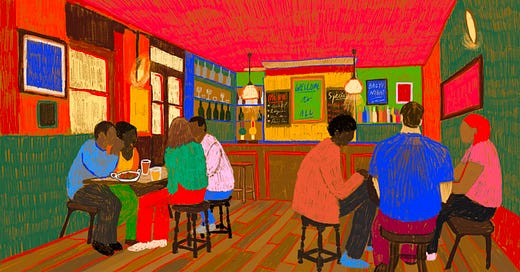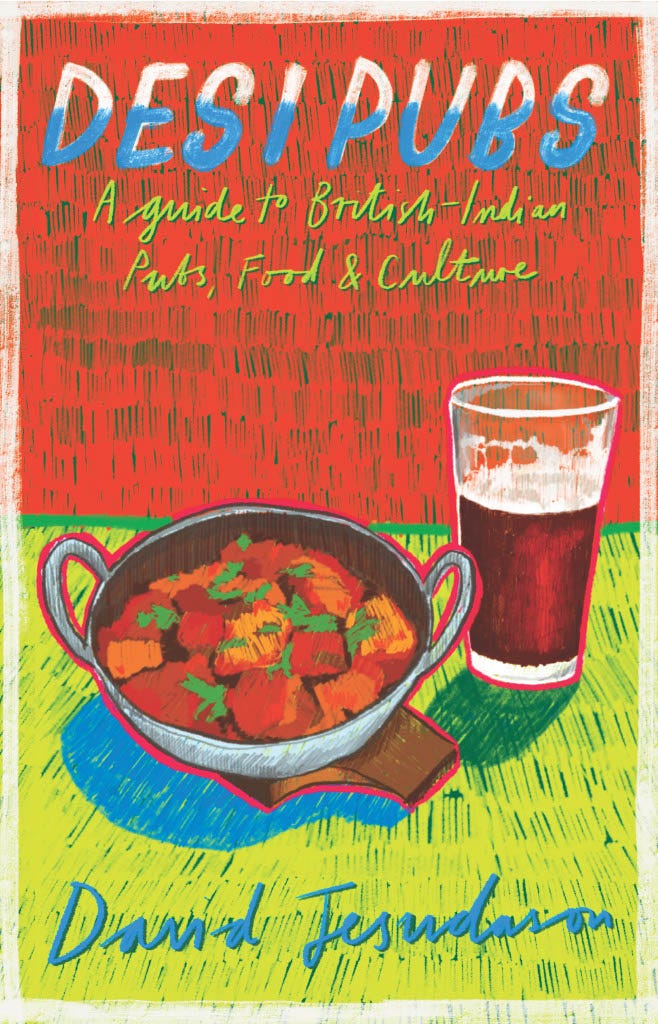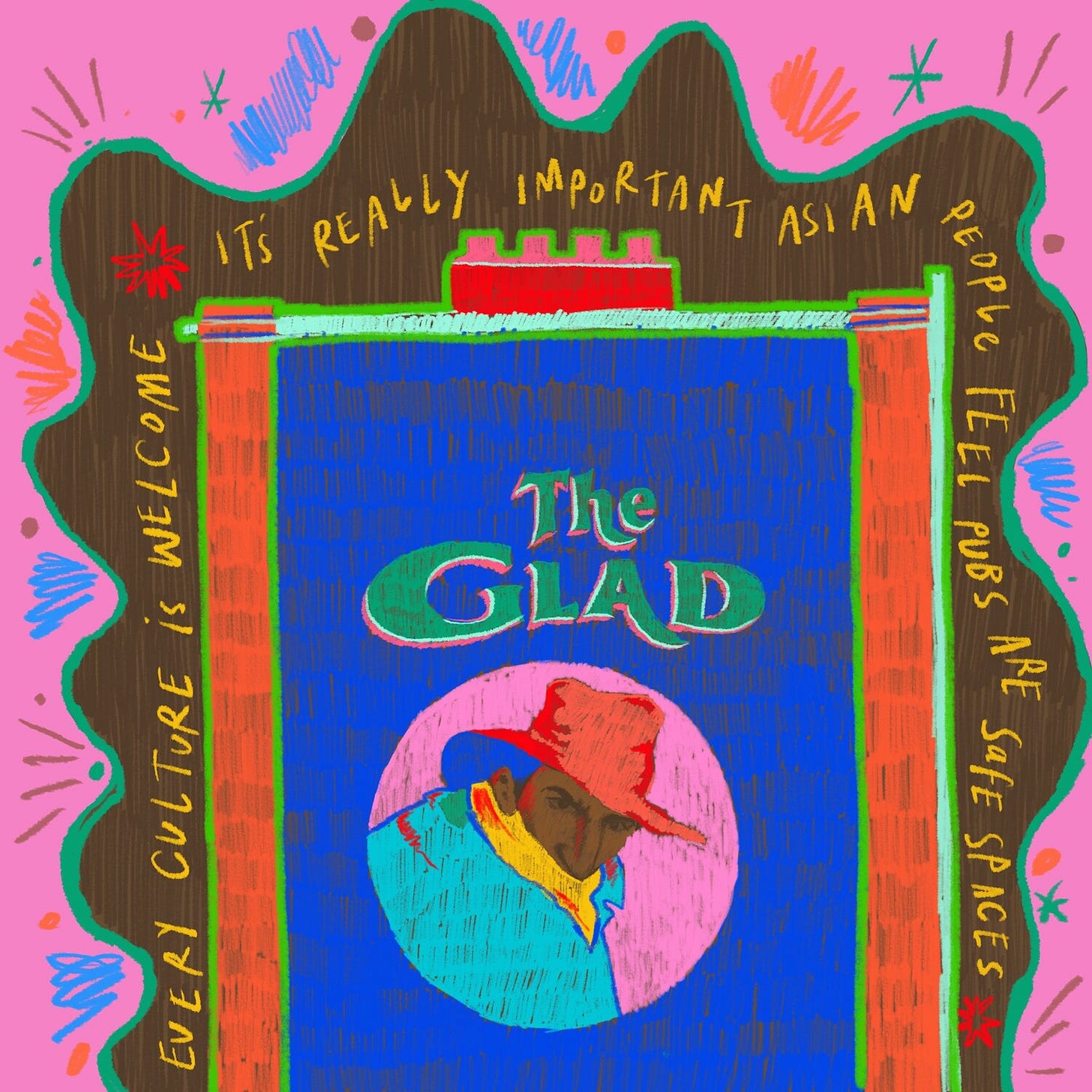Tida Bradshaw - the story behind the Desi Pubs' front cover
Tida went from working for BrewDog to creating beautiful beer illustrations. Without her my book on desi pubs wouldn't have had instant credibility
Disclaimer: this newsletter often mentions beer and pubs. You do not have to read this if your life has been affected by substance abuse.
I’d like to thank everyone who has donated to my Ko-Fi here. If you’ve not done so already please buy Desi Pubs - A guide to British-Indian Pubs, Food & Culture here.
If you like today’s article please pledge some funds here as it took a lot of time to put together.
Deep breath.
Taking a dramatic pause here might be the kind of thing Holly Willoughby might pre-rehearse before she launches into an over-earnest defence of a shamed co-presenter but in this instance I feel it’s needed. I never thought my book would be this successful - and it’s only been about a month since it’s been launched. A glorious daze. And best of all my complaints that British-Asian culture is always ignored has to stop. For now.
Sales have far exceeded expectations - we’re already talking about the next print run. The media - largely - have been really interested in the book. Best of all, people who bought Desi Pubs love it for opening up forgotten parts of the country to them and have cherished it for covering pubs they’ve never heard of and now want to visit. Many told me they felt excitement reading it. I’m not used to praise and I haven’t always dealt with it in a healthy way - and I’m spending too much time thinking about the compliments.
All this reminds me of a story Louise Wener of the band Sleeper tells in her autobiography Different for Girls. During the height of her popularity she sat in her bedroom alone, gazing at a photo where she was dressed in a catsuit taken for a lads’ magazine. She managed to feel totally disconnected from the person she saw but couldn’t help objectifying herself because she always was bullied at school for being ugly. It wasn’t healthy but she still would gaze at herself when she was feeling down despite the way she was portrayed and who she was pictured for - men.
She knew she shouldn’t have kept staring at this glossy photo but it appealed to her base vanity and I now can empathise with this unease. I like to think I’m not that kind of person but when I’ve worked so hard on a project and someone writes: “One of the most exciting books about beer and pubs in recent years” - I start to feel euphoric. It’s not healthy but I read that Boak and Bailey book review every day. Because I’m not used to being valued and, like Wener, I was bullied at school and made to feel worthless.
Pause.
But the reason the book is so successful isn’t all down to me - despite what a review from a publication I respect may suggest. The subject matter is prescient and the stories told by the desi pub landlords - their raw experiences - make the book what it is. And I had little influence over why it’s selling so well in bookshops up and down the country - that comes from its beautiful front cover.
The illustration by Tida Bradshaw (pronounced Teedar not Tyder - as I kept saying) gives the book instant credibility as the casual reader may not have heard of a desi pub and certainly doesn’t know who “David Jesudason” is. Put simply it’s beautiful and draws you in, fitting the subject matter perfectly and whisks you off to a pub that offers the best of India (the food), the best of Britain (the beer) and the best of India and Britain (the vibe).
So today’s newsletter it’s time to find out who Tida is and what influenced her to create a wonderful slice of desi-ness.
The idea for the book started with this Pellicle article which was the first time I had explored the subject of desi pubs. Aside from the subject matter, the entire webpage looks so good because the illustrations fit the copy - the pub scene is more or less the Gladstone in Borough, some of the details might be tinkered with, such as the sign, but it has the vibe of what it’s like to be sat in the finest pub seat you can find in South London.
It’s fair to say that Tida’s work has been a leitmotif in my career - and lots of other writers - so it’s embarrassing to reveal I hadn’t met her before until the book was launched. Fittingly, this was at the Glad. I knew nothing about the illustrator and designer apart from her great work dovetailed nicely with mine - she will be synonymous to Pellicle readers as she illustrated the website’s logo and creates incredible artwork to go with their frequent articles.
Tida’s father David was British, working as a VSO in an early version of TEFL and they met in Thailand when her mother was in her late 20s - she was a Maths teacher. They relocated to Hampshire in the mid-1980s - a town called Hedge End, near Southampton - and Methinee had to tolerate a lot of racism and sexism.
“A lot of south-east Asian microaggressions,” Tida tells me on Zoom, refreshed after a swim in Kilbride Bay, Scotland, “ with people automatically thinking of a ‘Thai bride’ when they hear of a white English man marrying a Thai person. [Aside from the racism and sexism] It’s presumptive of the woman marrying the man for something other than love.
“My dad never went to university, but my mum was from a very small village and got a grant to go to the best university in Bangkok. Super bright. Super intelligent woman.”
David was a pretty rootless individual, being born in Canada and living in places like Weston Super Mare. The couple moved to Hedge End because of a job he landed working as an activity instructor at nearby Fairthorne Manor and this was a huge culture shock for Methinee, who went from being an excellent Maths teacher to also working at this YMCA, but running the tuckshop.
“She was learning English still,” Tida admits. “And she was scared of entering the UK education system because she was scared of people making fun of her accent - which is really sad. And being in a British school, kids would’ve done that.”
“The cover for Desi Pubs is some of her best work yet,” says Matthew Curtis, writer, photographer and co-founder of Pellicle who commissioned the original artwork, which was then reused for my book. “I was just in awe of her use of colour, and how it reflected the vibrancy and energy of the pub.”
Even before I started writing a book I was pushing hard for the image to be used as the front cover. The budget would only stretch to one image - I would’ve liked to use more illustrations in the book - but it was so evocative of Indian sign writing that I knew it would immediately appeal to desi, as well, as white readers. When it was emailed as a PDF in the production stages, I couldn’t stop enthusing to my book editor and he actually said: “It was the best reaction we’ve ever had from an author to their front cover.”
And it’s not just me as Matthew isn’t launching into empty praise for a friend and colleague because she also designed the front cover for his latest book, which is equally as good.
“I was looking at Indian sign painting,” Tida tells me, “because it’s beautiful. The signage on lorries [etc] that’s hand painted by people - I really want to capture that sort of vibrancy. And also the warmth of a pub - I wanted it to feel celebratory, vibrant and alive.”
Those last three adjectives were what I strived for in the book and I hope readers feel it matches their experiences of it. Aside from the front cover, Tida also drew some amazing images for the rest of the desi pub article including one scene based on the interior of the Glad.
As I said I met Tida in that pub for the first time and the whole experience must have been unnerving because she hadn’t visited before but realised it in her illustrations like she was a regular. Despite never setting foot in the door, Tida completely nailed the cosmopolitan, laid-back vibe of London’s most central desi pub.
“I wanted to go and it was on the list,” Tida admits. “As an illustrator you always hope to capture something more when you’re using a flat piece of artwork.”
“My brother is three years younger than me,” Tida says, “and he looks quite different to me - he looks a lot more Thai. And I look quite white passing. But I have a Thai name and my brother is called Tom - so we had quite different experiences.
“For me school was easy, fun and I loved it. He also had a good time but he experienced racist incidents and microaggressions. And I didn’t. I have spoken to him a lot about this and he’s always said he was seen as ‘the Asian one’ in his group of friends. Whereas that’s never been the case for me.”
Tida quit university when she was 20 due to mental health issues, moved to London and started working for BrewDog in its early days in January 2013. It was in the Shoreditch pub, which Tida believes was then only their second pub after the Camden branch, which first exposed her to the beer world - she enjoyed the experience which is very different to other people I have interviewed. It was before craft had taken off, though, BrewDog hadn’t expanded and become the infamous BrewDog we now know, which also allowed this Shoreditch outpost to then retain its autonomy.
“It was niche people drinking weird beer,” Tida tells me. “It was an independently run BrewDog pub. It didn’t have the same branding, didn’t have the same management style, and was run and managed by really good people. And I had a good time.
“Towards the end of that there were incidents and that’s when it started to go downhill with allegations of abuses of power, sexism and general bad treatment of staff from management and James Watt himself. I didn’t experience it myself.”
Before things turned sour at BrewDog, Tida was given free rein to design signs, T-shirts and posters despite never studying art at university. She had a love of drawing and painting and this was her first blank canvas, one that was remembered by Mark Hislop, who was a manager there but then moved on to Redchurch Brewery.
Tida followed Mark there in 2014 and the brewery in those days was small but “made great beer”. They built a taproom in Bethnal Green, with Tida running the bar as well as designing labels for their Urban Farmhouse project. Then she worked for EMI in a music production role - which allowed her to design artwork - and then found herself at Affinity brewery in 2015. Finally, she became the excellent freelance illustrator she is today by taking the plunge in 2018.
“Affinity Brew Co,” Tida says, “who were Ben [whom I interviewed here] and Steve, approached me to do their artwork for their logo and their beer. I did all of their labels.
“Through conversations and people I met in beer and music - but mainly beer - I was able to make a living doing drawings for people.”
A year later, when Tida was living in Portugal she received an email from Matthew and brewer Johnny Hamilton, the founders of Pellicle, to design the logo for their new website. “Ever since then,” she adds, “they’ve been commissioning me to do articles - including your wonderful articles.”
Tida admits when she was given the commission for the original desi pub article she had never heard of a desi pub but what I wrote about striving to find welcoming spaces had universal appeal, she believes, and resonated with her life.
“I’m sure so many people have felt [what you felt] and felt out of place in pubs,” she says.
The uplifting consequence of my book gaining a wide audience is that more and more people are visiting pubs they haven’t been to before, making them feel at ease in new surroundings. And it’s not just white people visiting desi pubs for the first time - it’s brown drinkers too. This week I visited the Regency to be interviewed and I bumped into the landlord Rahul Sharma who was enthusiastic about the book’s reach.
He told me that a lot of his customers were now visiting other desi pubs too and there was more influx from other bars too, which is something I never expected because if you finally find a safe space it takes a lot to change a habit.
Which shows it might be good to be a local of one pub but due to mine and Tida’s work people are starting to see themselves as regulars of many desi pubs.
What we can learn from this is Pellicle supports independent writers and artists. Therefore, please support it!
This article was amended on 23-06-23 as I mistook Affinity Brew Co for Infinity Brew Co







